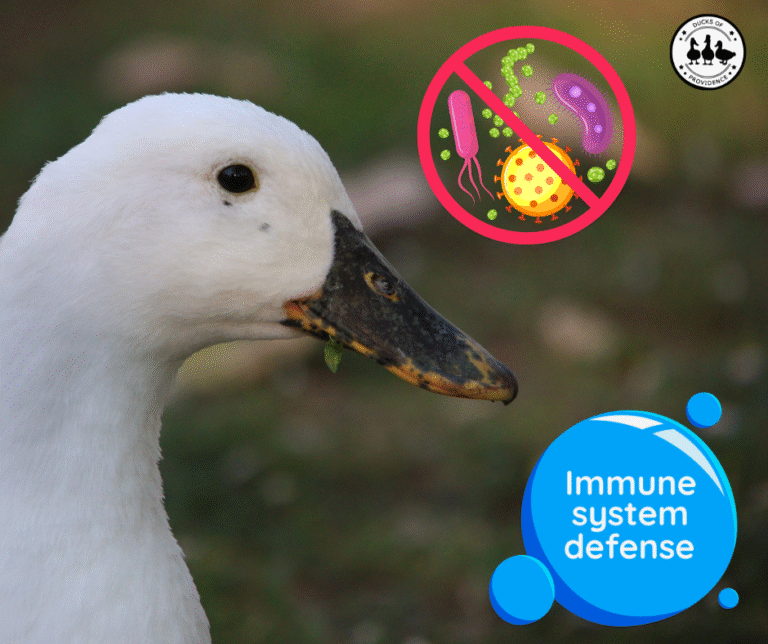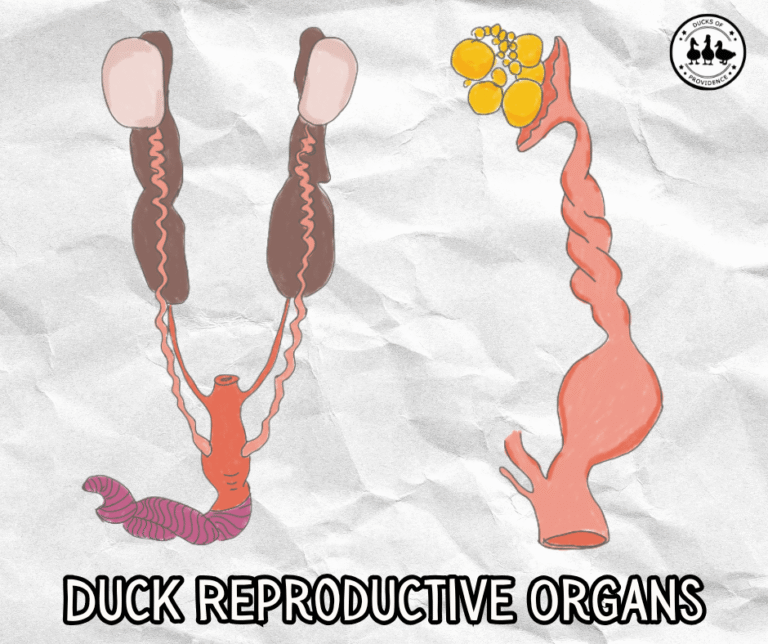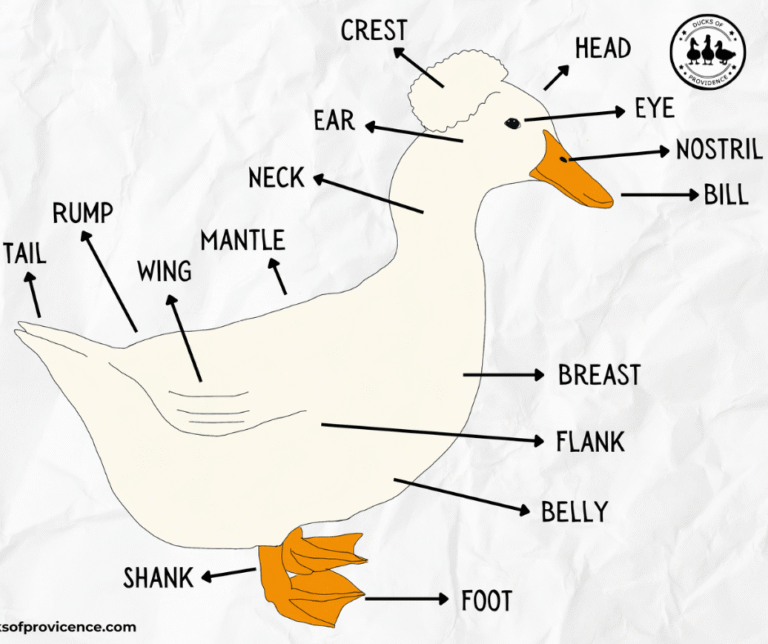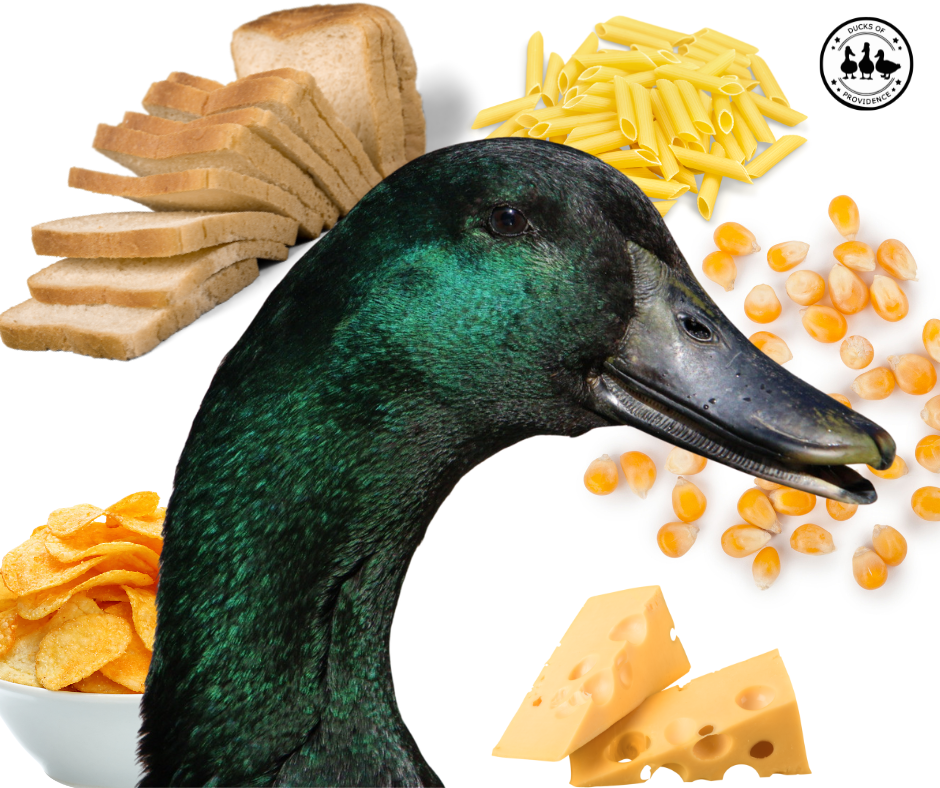
Duck Nutrition Myths vs. Facts: What Your Flock Really Needs
Last updated on September 3rd, 2025 at 07:55 pm
Feeding ducks seems simple—after all, they’ll happily gobble up almost anything you offer. But as a duck mom and a scientist, I’ve learned that “what ducks will eat” and “what ducks should eat” are two very different things.
A big part of the confusion comes from the fact that most information about duck diets comes from the farming world. Ducks raised for meat or commercial egg production are often fed differently than ducks kept as pets because the goals are different. In farming, the focus may be on rapid weight gain or high egg output, often over a relatively short lifespan. Pet ducks, on the other hand, are family members. We want them to live long, healthy, comfortable lives, often well over a decade, and that means their diet needs to support long-term health, not just short-term production.
In this guide, I’ll debunk some of the most common duck nutrition myths, explain where they come from, and show you how to feed your pet ducks in a way that’s both safe and backed by science.
Ducks of Providence is free, thanks to reader support! Ads and affiliate links help us cover costs—if you shop through our links, we may earn a small commission at no extra cost to you. Thanks for helping keep our content free and our ducks happy! 🦆 Learn more
Myth #1: Bread is a Great Duck Food
The Myth: Ducks love bread, so it must be good for them.
Where It Comes From: For generations, families have gone to ponds or lakes to feed ducks bread. It’s become such a cultural tradition that many people grew up believing bread was the food for ducks. It’s cheap, accessible, and ducks run eagerly toward it, so it looks like the perfect treat. But what seems harmless fun at the park can have very real health consequences, especially for ducks kept as pets, who may get bread more regularly.
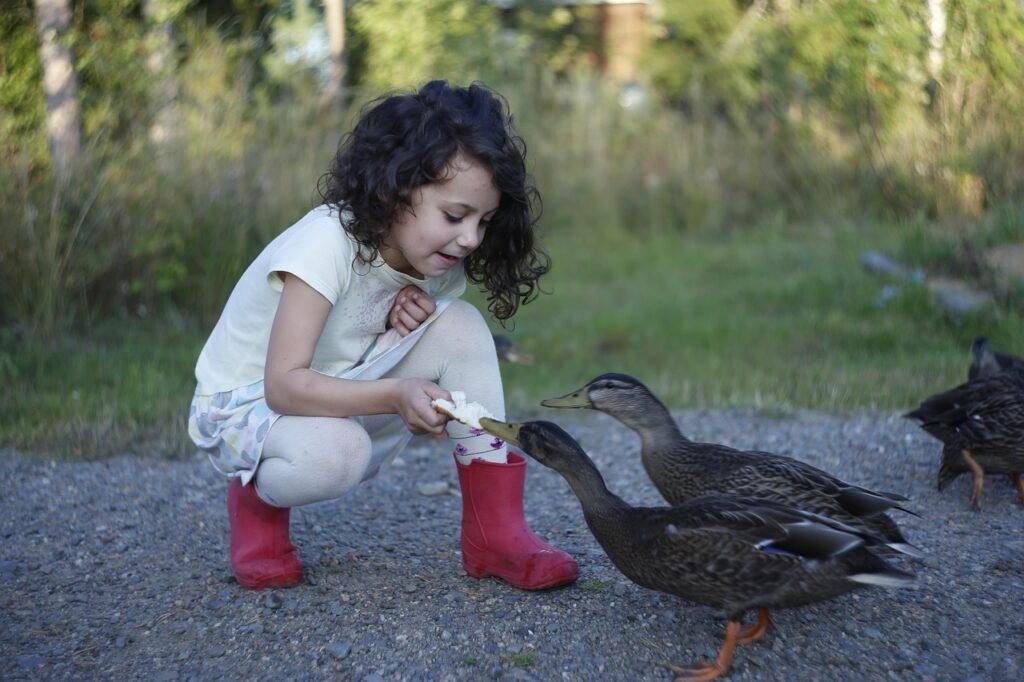
The Fact: Bread is basically empty calories for ducks. It’s high in carbohydrates, low in essential nutrients, and does little to support feather growth, bone development, or egg production. In fact, filling up on bread often means ducks eat less of the nutrient-rich foods they actually need. Over time, this can lead to:
- Malnutrition – Ducks miss out on vitamins, minerals, and protein.
- Obesity – Extra carbs without balance leads to excess fat storage.
- Angel Wing – A deformity where the wing tips twist outward, often linked to diets too high in carbs and protein imbalances during growth.
- Digestive Issues – Especially if bread is moldy, which can introduce harmful fungi.
For wild ducks, too much bread also creates environmental issues. Leftover soggy bread pollutes water, encouraging algae growth and pests, and it disrupts natural foraging behaviors.
Why It Matters for Pet Ducks: Unlike wild ducks, who may only encounter bread occasionally, pet ducks could be offered it more often, especially if well-meaning owners are looking for easy snacks. But pet ducks live much longer lives than their wild counterparts, so long-term effects of poor nutrition really add up. We want glossy feathers, steady egg-laying, and strong legs—not preventable health problems.
From My Flock: My ducks beg for snacks just like any pet would, and yes, they would happily eat bread if I let them. But knowing the risks, I stick to healthier treats. Peas, lettuce, cucumber, and dried grubs are their favorites. Watching them dive for floating peas in the water is so much more rewarding than handing them a slice of bread.
Better Option: If you want to give your ducks a treat that’s just as fun but actually beneficial, try:
- Peas (fresh, frozen, or thawed—not canned, since that contains added salt).
- Chopped leafy greens like romaine, kale, or spinach, tossed in water for dabbling.
- Diced cucumber, melon, or zucchini in moderation.
- Dried black soldier fly larvae (Grubblies) or mealworms for protein.
These options satisfy their desire for snacks while supporting health, feather condition, and overall well-being.

Bottom Line: Bread isn’t a treat; it’s junk food. Pet ducks don’t need it, and with so many healthier (and just as beloved) alternatives, you won’t miss it.
Myth #2: Ducks Can Eat Anything Humans Eat
The Myth: Ducks can share all our leftovers.
Where It Comes From: On traditional farms, poultry were often treated as part of the waste management system. Leftover scraps, from grains to vegetable peelings to even bits of dairy, were tossed into the barnyard so nothing went to waste. Ducks, with their hardy appetites, often seemed to handle it. Over time, this practice shaped the belief that “if humans can eat it, ducks can too.”
The Fact: Ducks are resilient, but their digestive systems and metabolisms aren’t the same as ours. While they can safely eat some fresh fruits, vegetables, and whole grains, many human foods are either unhealthy or downright toxic to them. For example:
- Salty snacks (chips, pretzels, processed foods) → strain the kidneys and dehydrate ducks.
- Chocolate and caffeine → toxic to birds’ nervous systems.
- Avocado → contains persin, which is poisonous to birds.
- Onions, garlic, chives → can damage red blood cells, leading to anemia.
- Sugary foods and baked goods → cause weight gain and disrupt balanced nutrition.
- Greasy or fried foods → difficult to digest, leading to diarrhea and nutrient malabsorption.

Even foods that seem harmless, like pasta or rice, are usually just empty carbohydrates without meaningful nutrition. Feeding these regularly means your ducks may fill up on calories but miss the essential vitamins, minerals, and proteins they truly need.
Why It Matters for Pet Ducks: Farm ducks raised for meat often only live 6–8 weeks, and even laying hens are rarely kept more than a few years in commercial settings. The long-term effects of poor nutrition simply weren’t considered. But for pet ducks, who can live 10–15 years, every bite matters. Consistently feeding the wrong foods can lead to obesity, heart strain, fatty liver disease, and nutrient deficiencies that shorten their lives and reduce quality of life.
From My Flock: My ducks are endlessly curious about everything I eat. If I sit outside with a sandwich, they’ll crowd around, craning their necks to see what I’ve got. And yes, it’s tempting to “share” a little cookie or cracker when they beg, it feels like treating them as part of the family. But I remind myself that their bodies aren’t built for processed food. Instead, I keep duck-safe treats nearby: cucumber slices, peas, or lettuce. They’re just as happy, and I have peace of mind knowing I’m not harming them.
Better Option: Stick to fresh produce, whole grains, and duck-approved snacks that provide real nutritional benefits. Think “fresh, not processed.” If you’re looking for inspiration, I put together a whole post about healthy snacks for ducks that lists safe, nutritious options my flock loves. It’s a great resource when you want to offer treats that are fun, tasty, and actually good for them.
Myth #3: Whole Corn is All Ducks Need
The Myth: Ducks thrive on corn alone.
Where It Comes From: Corn has long been the go-to feed for farm ducks. It’s inexpensive, widely available, and easy to store in bulk. For ducks raised for meat, who are typically processed at just 6–8 weeks old, corn provides the calories needed to quickly gain weight. Since these ducks don’t live long enough to show the effects of nutritional deficiencies, the practice of feeding “just corn” has persisted in some circles as accepted wisdom.
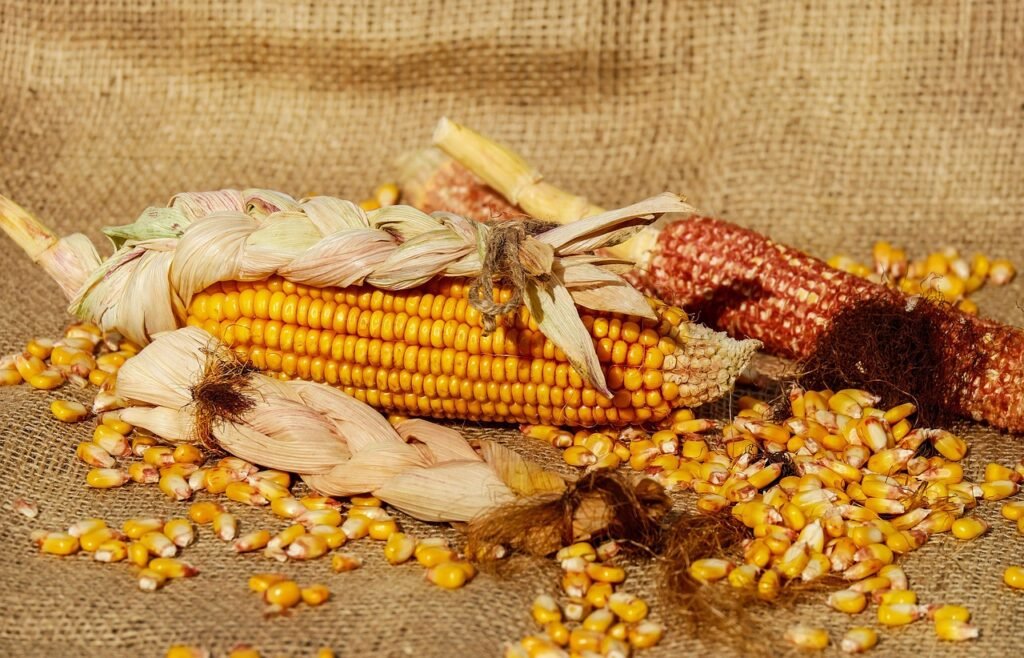
The Fact: Corn is high in carbohydrates and calories but extremely limited in what it offers nutritionally. It contains:
- Low protein (about 8–9%), far below the 14–17% adult ducks need for maintenance or the 18–20% ducklings need for proper growth.
- Imbalanced amino acids – Methionine and lysine, both crucial for feather growth and muscle development, are present only in small amounts.
- Deficient vitamins and minerals – Corn lacks adequate calcium, niacin, vitamin D, and many trace minerals.
A diet centered around corn leads to:
- Obesity – Too many carbs without balance turn into fat, putting strain on joints, the heart, and liver.
- Fatty liver disease – Common in ducks fed high-energy diets without enough exercise or balanced nutrients.
- Poor feather quality – Feathers become dull, brittle, or patchy without proper protein and amino acids.
- Reduced egg quality and production – Calcium and protein deficiencies directly affect egg strength and laying consistency.
Why It Matters for Pet Ducks: While corn may keep farm ducks alive for a short time, it sets pet ducks up for years of health problems. Pet ducks often live 10–15 years, and obesity or liver disease can shorten that drastically. Feeding mostly corn is like raising a child on candy bars, filling, sure, but with devastating long-term consequences.
From My Flock: I do offer cracked corn, but only as a seasonal treat in the winter. Corn provides extra calories that help my ducks generate body heat during freezing nights. I’ll sprinkle it as a bedtime snack, knowing it’s useful when temperatures dip, but I never rely on it as their main diet. It’s enrichment and energy, not a substitute for balanced feed.
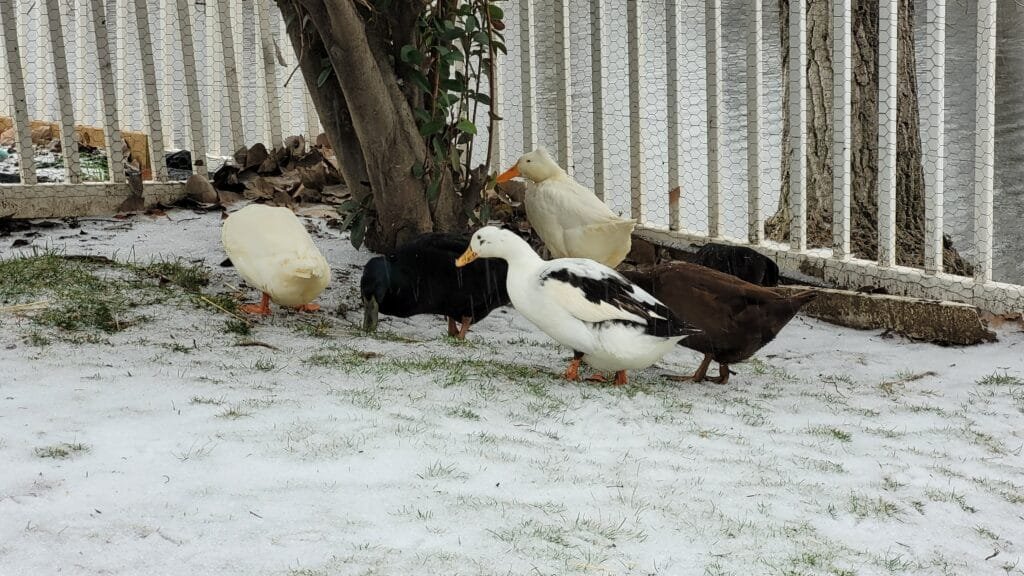
Better Option: Reserve corn for:
- Cold-weather energy boosts
- Training rewards (a sprinkle of cracked corn works wonders for recall training!)
- Occasional enrichment (scattered for them to forage)
But the foundation of every pet duck’s diet should be a formulated waterfowl or all-flock feed with 14–17% protein, added niacin, and a complete vitamin/mineral balance. This is what keeps feathers glossy, eggs strong, and bodies healthy over the long term.
Nutritional Comparison: Common “Myth Foods” vs. Balanced Duck Feed
When it comes to feeding ducks, many of the foods people reach for, like corn, bread, rice, or pasta, are filling but fall short on real nutrition. Ducks will happily eat them, but that doesn’t mean they should form the bulk of their diet. To show the difference, here’s a quick comparison of these common “myth foods” against a balanced duck feed formulated for long-term health.
| Food Item | Protein (%) | Key Nutrients Present | Key Nutrients Missing | Notes for Pet Ducks |
|---|---|---|---|---|
| Corn | ~8–9% | Carbohydrates, small amounts of vitamin A | Niacin, calcium, vitamin D, essential amino acids (methionine, lysine) | Energy-rich but nutritionally incomplete. Safe as a treat in winter but not a diet staple. |
| Bread | ~7–8% (varies) | Carbohydrates | Almost everything: protein, vitamins, minerals | Essentially “junk food.” Fills ducks up but leads to malnutrition, obesity, and angel wing. |
| Rice (white, cooked) | ~2–3% | Easy-to-digest carbohydrates | Protein, calcium, vitamins, minerals | Can be offered in small amounts as a treat, but nutritionally empty. Brown rice is slightly better. |
| Pasta (plain, cooked) | ~5–7% | Carbohydrates, a little protein | Vitamins, minerals, balanced amino acids | Ducks enjoy it, but it’s just empty calories. Offer sparingly, never as a main food. |
| Balanced Duck Feed | 14–17% (adults), 18–20% (ducklings) | Complete amino acids, niacin, calcium, phosphorus, vitamins A, D, E, selenium, other trace minerals | None (formulated to meet all daily needs) | Should make up at least 90% of a pet duck’s diet. Formulated specifically for long-term health. |
Myth #4: If It’s Safe for Chickens, It’s Safe for Ducks
The Myth: Ducks can eat the same feed as chickens.
Where It Comes From: Many backyard keepers raise chickens and ducks together. Feed stores often stock primarily chicken feed, so it’s easy to assume that one bag can cover both species. For farm purposes, where ducks are sometimes raised only for meat or short-term egg production, chicken feed often “works well enough.” But for pet ducks, who may live 10–15 years, “well enough” isn’t good enough.
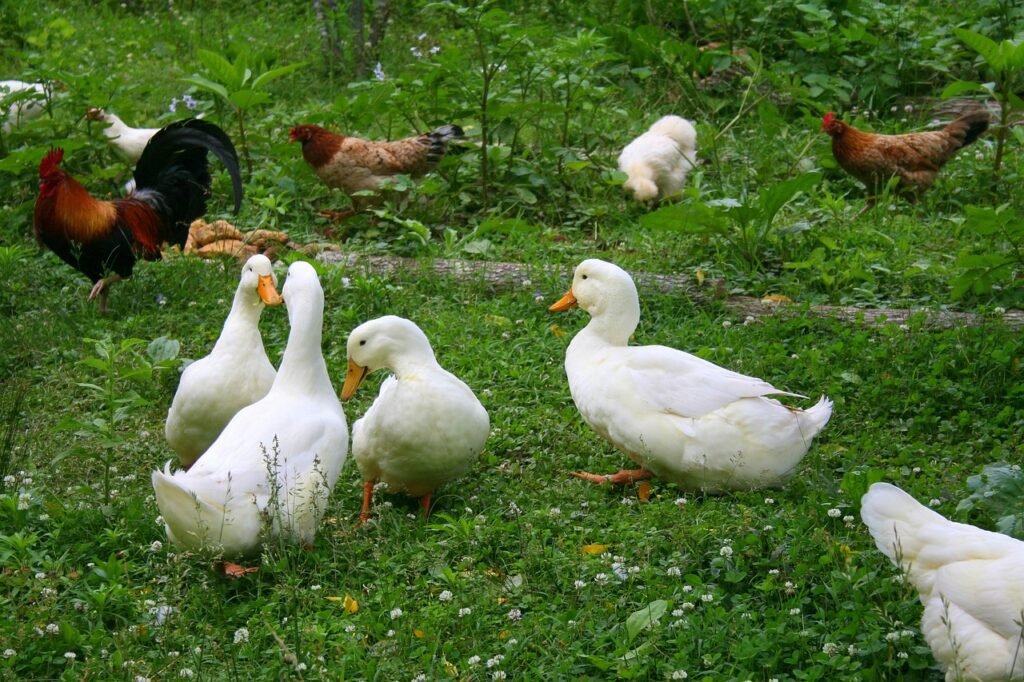
The Fact: Chickens and ducks share some dietary needs, but their requirements are not identical. There are key differences in both nutrients and feeding behaviors:
- Niacin (Vitamin B3): Ducks require more niacin than chickens throughout their lives—not just as ducklings. Adult ducks who are chronically low in niacin may show subtle signs such as joint stiffness, reduced activity, or bumblefoot susceptibility. Chickens can get by on lower levels, but ducks need higher niacin for strong legs and joint health over the long term.
- Macronutrient Balance: Ducks often benefit from slightly higher protein and energy intake than chickens, especially during molting or laying seasons. They also process fats differently, using them more efficiently as an energy source, while chickens rely more heavily on grains.
- Calcium Needs: Laying ducks and chickens both require extra calcium, but ducks tend to have larger eggs and lay more consistently in certain breeds, meaning their calcium demands can be even greater.
- Feeding Behavior – Bill vs. Beak: Chickens peck at food with a pointed beak, while ducks scoop and dabble with their flat bills. Ducks need access to water while eating so they can wash down feed and avoid choking. They’re also messy eaters compared to chickens—dunking, splashing, and “sifting” through food with their bills. This difference affects not only what they eat, but how feed should be offered (with water dishes placed right next to feeders, or feed served in shallow water).
Why It Matters for Pet Ducks: For short-lived farm ducks, long-term deficiencies may never show up. But pet ducks kept for companionship require nutrition that supports decades of health—strong bones and joints, healthy feathers, and steady egg production. A diet built around chicken feed may leave subtle nutrient gaps that, over years, add up to lameness, reproductive problems, or shortened lifespan.
From My Flock: Even though we don’t keep Jumbo Pekins, we’ve always made sure our ducklings received a duck-specific starter feed with added niacin. That early foundation sets them up for strong legs and healthy growth. As adults, we rotate between high-quality waterfowl or all-flock feeds to ensure they’re getting the right balance of protein, niacin, and minerals, not just whatever is convenient at the feed store.
Better Option:
- Use a waterfowl-specific starter feed for ducklings.
- For adults, choose formulated waterfowl or all-flock pellets with adequate niacin and protein (14–17% for maintenance, slightly higher for layers or during molt).
- If chicken feed is the only option locally, supplement with niacin (150 mg/gallon of water) or brewer’s yeast, and make sure oyster shell is available for layers.
- Always provide feed next to water deep enough for ducks to submerge their bills.
Bottom Line: Ducks are not just “wet chickens.” They have their own unique needs, and meeting them makes all the difference between “getting by” and truly thriving. Or would you give your cats dog food regularly?
Myth #5: Milk and Dairy are Good for Ducks
The Myth: Ducks can drink milk or eat dairy products to get extra calcium and protein.
Where It Comes From: On traditional farms, nothing went to waste. Leftover milk, whey, or bits of cheese were often fed to pigs, chickens, and ducks as a cheap source of calories. Poultry seemed to eat it eagerly enough, so many assumed it was safe and even beneficial. This practice carried over into backyard farming traditions, and some keepers still believe milk strengthens bones and helps with egg production.
The Fact: Ducks are lactose intolerant. Like all birds, they lack the enzyme lactase, which is required to break down lactose, the sugar found in milk. Without this enzyme, lactose passes through the digestive system undigested, drawing excess water into the intestines and fermenting in the gut. The result is:
- Diarrhea (watery droppings)
- Dehydration (a dangerous risk, especially in hot weather)
- Nutrient loss (because food passes too quickly for nutrients to be absorbed)
- Gut imbalance (fermentation disrupts healthy gut microbes, potentially leading to secondary infections)
Cheese and yogurt may contain less lactose than milk, but they are still risky for ducks and provide no benefits that can’t be obtained from safer, bird-appropriate foods.
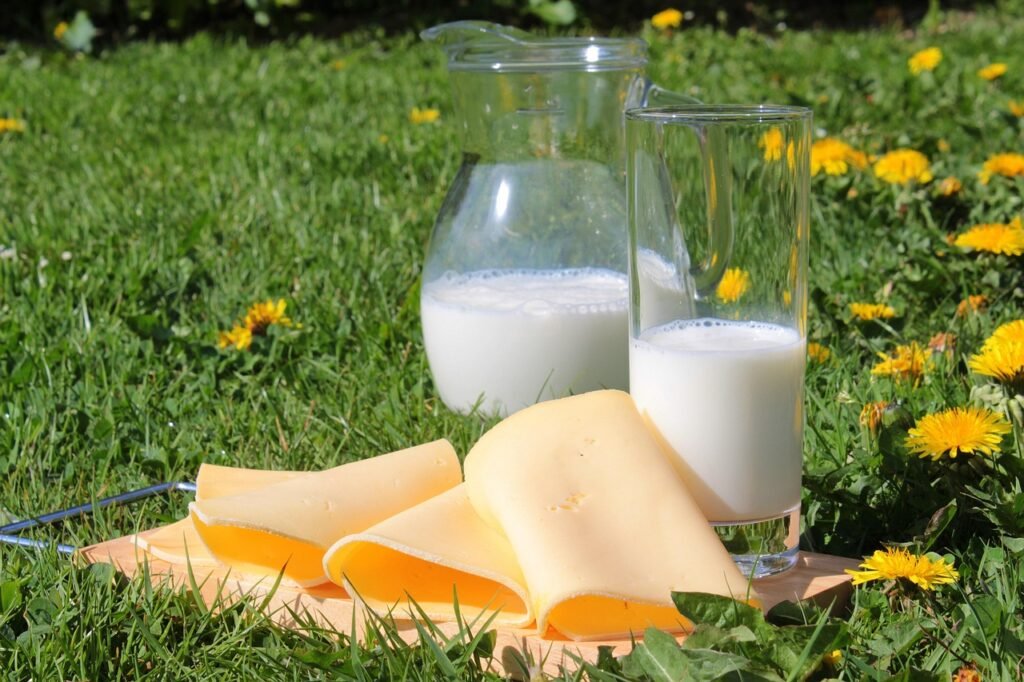
From a nutritional perspective, while dairy products contain calcium and protein, they come in a form that ducks cannot process efficiently. What is “bone-building” for humans is, in reality, stressful to a duck’s digestive system.
Why It Matters for Pet Ducks: Calcium is absolutely essential, especially for laying hens, who use around 2 grams of calcium carbonate per egg shell. Without proper calcium intake, ducks face:
- Thin or shell-less eggs
- Egg binding (dystocia)
- Reproductive infections and stress
- Weakened bones from calcium depletion
But dairy isn’t the way to provide it. Instead, feeding milk or cheese can undermine a duck’s overall health, particularly if offered regularly.
From My Flock: My laying hens always have access to crushed oyster shell in a separate dish, and they instinctively eat it as needed. It’s the safest and most reliable way to support strong eggshells and long-term health. I sometimes also recycle baked, crushed eggshells as a supplement, though oyster shell remains my go-to.
And here’s my honest confession: my duck Krümel does get the occasional tiny piece of cheese as a special treat. It’s very rare and always in tiny amounts, and it’s more about bonding than nutrition. She loves it, but I know it’s not something to include in her diet regularly. That balance, understanding the risks, but choosing moderation with eyes open, matters. For the rest of the flock, I stick to calcium sources designed for ducks.
Better Option:
- Provide oyster shell in a dish for layers to take when needed.
- Offer baked, crushed eggshells if you want to recycle calcium from your flock.
- Make sure their base feed includes the correct balance of calcium, phosphorus, and vitamin D3 (all needed for proper calcium metabolism).
Bottom Line: Ducks may nibble cheese or sip milk with enthusiasm, but that doesn’t make it healthy. Their bodies aren’t designed to digest dairy, and the risks outweigh the benefits. Stick to calcium sources that actually work for ducks, and you’ll see the results in healthier ducks and strong, reliable eggs.
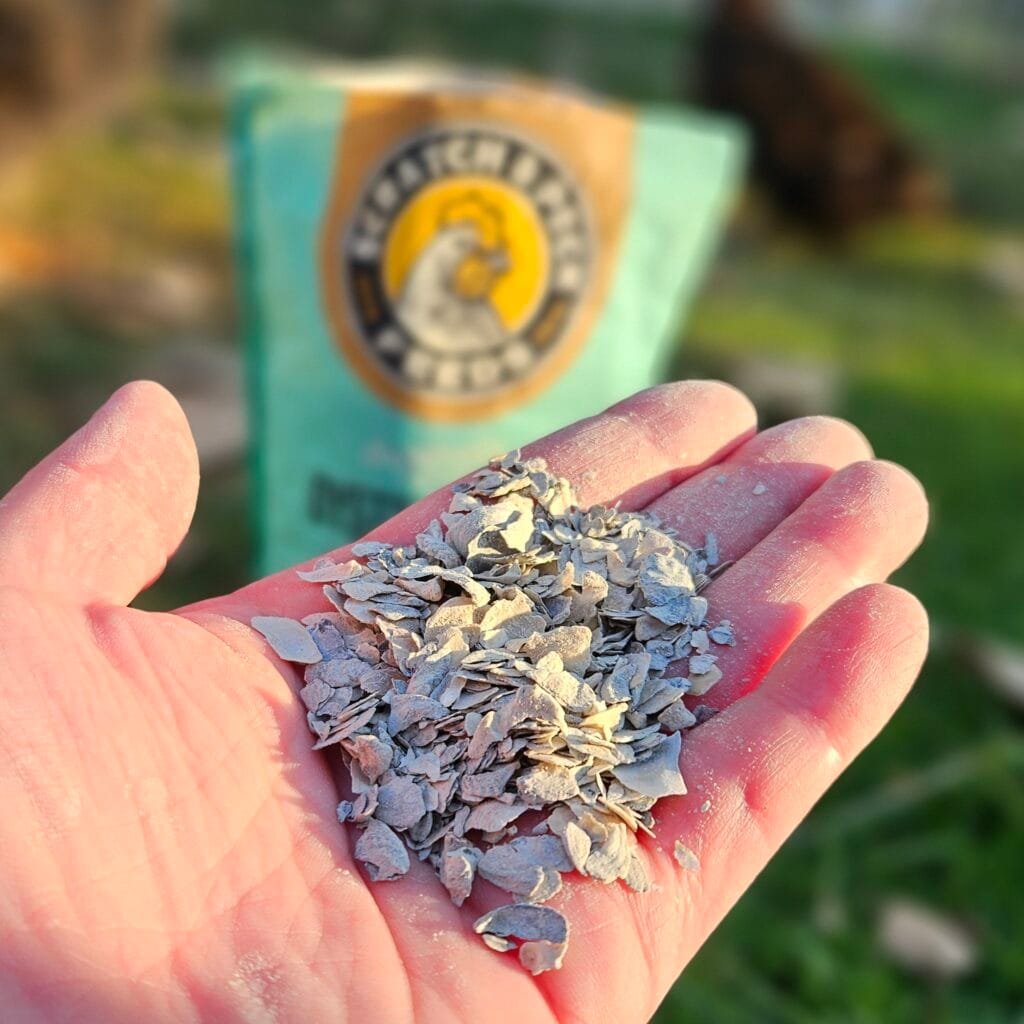
Myth #6: They Can Forage Everything They Need
The Myth: Ducks don’t need feed if they free-range.
Where It Comes From: Historically, ducks were often kept on farms with large ponds, fields, or rice paddies. They foraged for weeds, grasses, snails, and insects, and farmers might only supplement with corn or grain during certain seasons. For ducks raised primarily for meat, this was “enough,” since their lifespan was short and nutrient deficiencies often didn’t have time to show. Over generations, this created the belief that free-ranging ducks can fend for themselves nutritionally.
The Fact: Foraging is healthy, but it isn’t nutritionally complete. Ducks are opportunistic omnivores; they’ll happily eat grass, weeds, seeds, insects, slugs, and even small fish or amphibians if available. But what they find depends heavily on the season, weather, and environment.
- Summer: Bugs, weeds, and fresh greens may be abundant.
- Winter: Insects are gone, plants are dormant, and frozen ground makes foraging nearly impossible.
- Urban/Suburban Backyards: Available forage is often limited and may contain pesticides, fertilizers, or pollutants.
Even in ideal environments, natural forage rarely provides enough of certain essentials:
- Protein for feather regrowth, egg laying, and muscle strength.
- Niacin (Vitamin B3) for strong legs and joint health.
- Calcium for eggshell formation and bone strength.
- Trace minerals and vitamins (like selenium, phosphorus, vitamin D3) needed for metabolism and skeletal integrity.

Wild vs. Domestic Ducks:
Wild ducks are able to feed themselves in natural habitats, but they also rely on behaviors domestic ducks have largely lost:
- They migrate to follow food availability and seasonal changes, traveling thousands of miles if needed.
- They have strong instincts to forage widely and diversify their diets, from aquatic vegetation to invertebrates.
- They’re not bred for rapid growth, oversized body weight, or high egg production like many domestic breeds are.
Domestic ducks, especially those bred for meat or egg-laying, often have weaker foraging instincts, heavier bodies that limit mobility, and a dependence on humans for nutrition. Expecting them to thrive on forage alone simply isn’t realistic.
Why It Matters for Pet Ducks: Unlike wild ducks, pet ducks can’t migrate to find food, and unlike farm ducks, they need nutrition that supports years of healthy life. Foraging is wonderful enrichment and should be encouraged, but it can never replace a balanced feed that covers every nutritional need.
From My Flock: My ducks spend hours happily nibbling grass, digging for worms, and chasing bugs in the yard. It’s enriching, and I love watching them do it. But I also keep a feeder of balanced pellets available at all times. That way, foraging becomes fun, not survival, and I know they’re getting the nutrition they need every single day.
Better Option:
- Treat foraging as bonus enrichment, not the main diet.
- Always provide a complete duck or all-flock feed as the foundation (at least 90% of their diet).
- Supplement with safe treats like leafy greens, peas, or dried grubs.
- Ensure foraging areas are free from pesticides, fertilizers, and toxic plants.
Bottom Line: Foraging is important, but it isn’t enough. Wild ducks migrate to follow seasonal food, and commercial farm ducks don’t live long enough to show the downsides of limited diets. Pet ducks, however, need us to bridge that gap—offering balanced feed alongside the joy of natural foraging—so they can thrive for many years.
Myth #7: More Protein is Always Better
The Myth: Ducks thrive on high-protein diets, so giving them extra protein will make them healthier and stronger.
Where It Comes From: On commercial farms, meat ducks are often fed very high-protein diets to speed up growth. The goal is efficiency—reaching slaughter weight as quickly as possible. Since these ducks are processed at just 6–8 weeks old, long-term effects of excessive protein (such as joint strain or kidney damage) never become a concern. This practice created the misconception that “the more protein, the better” applies to all ducks.
The Fact: Protein is essential; it’s the building block for feathers, muscles, enzymes, and hormones. Ducks need protein to grow, lay eggs, and regrow feathers after molting. But too much protein, especially long-term, is harmful.
Here’s why:
- Ducklings: Require 18–20% protein in starter feed to fuel rapid growth. More than 20–22% for extended periods can contribute to angel wing, a condition where the wing joints grow abnormally and the wing tips stick out sideways. This happens because excess protein and calories disrupt the balance of growth in muscles vs. bones.
- Adult Ducks: Do best on 14–17% protein during normal maintenance. Higher levels strain the kidneys and can lead to gout (uric acid buildup in joints and organs).
- During Molt or Heavy Laying: A temporary boost (16–19%) supports feather regrowth and high egg production. But once the molt ends or laying slows, going back to normal levels is important to prevent overloading the system.

Why It Matters for Pet Ducks: Pet ducks aren’t being raised for rapid meat production. They’re with us for the long haul—10 years or more—and that means we must prioritize long-term organ and joint health, not just fast growth or egg output. Chronic over-protein feeding can shorten a duck’s life, cause preventable health problems, and lower their quality of life.
Wild vs. Domestic Ducks:
Wild ducks naturally adjust protein intake seasonally:
- In spring and summer, they eat more insects and snails (higher protein) to fuel breeding and molt.
- In fall and winter, their diet shifts to seeds, grasses, and aquatic plants (lower protein).
Domestic ducks rely on us for feed and don’t have the same natural regulation, so it’s up to us to mimic what’s healthy for their bodies.
From My Flock: During molt, I give my ducks a little extra protein, like dried black soldier fly larvae (Grubblies) or mealworms, because feather regrowth demands it. They love it, and it helps them replace those new feathers quickly. But I’m careful not to overdo it. Outside of molt or laying, they get their regular balanced feed. That way, their kidneys aren’t strained, and I know I’m protecting their health for the long term.
Better Option:
- Ducklings (0–8 weeks): 18–20% protein (with proper niacin supplementation).
- Growing/juvenile ducks (8–16 weeks): Step down gradually to 15–16% protein.
- Adult maintenance: 14–17% protein is ideal.
- Molting or laying adults: Temporarily increase to 16–19%.
- Treats: Insects, grubs, or mealworms are great protein boosts when needed, but shouldn’t replace balanced feed.
Bottom Line: Protein is vital, but balance is everything. Ducks need the right amount at the right time—not a constant overload. A diet matched to their life stage ensures strong feathers, healthy organs, and the best chance at a long, happy life.
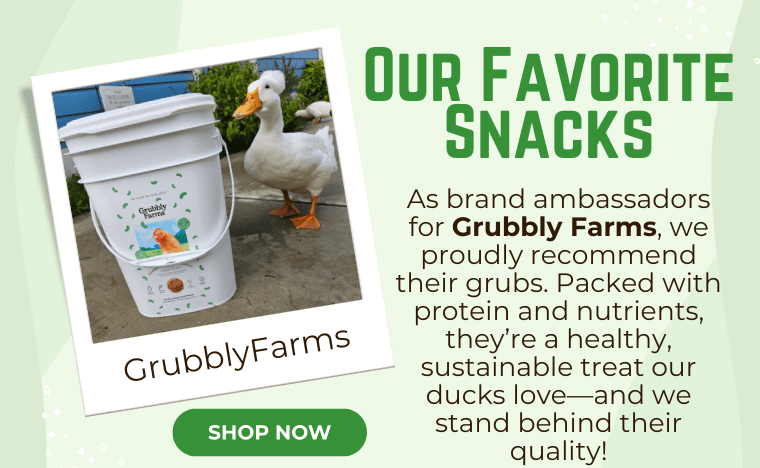
Science-Backed Feeding Strategy for Pet Ducks
For ducks kept as pets, the goal isn’t just survival or rapid production—it’s long-term health, mobility, and quality of life. Pet ducks can live well over a decade, and what we feed them every day plays a huge role in how healthy and happy those years will be. Here’s the foundation I recommend, based on both research and years with my own flock:
Base Diet: Complete Feed First
- Choose a high-quality waterfowl or all-flock pellet with balanced protein (14–17% for adults, 18–20% for ducklings) and the right niacin levels.
- Look for feeds formulated with amino acids like methionine and lysine, which support feather strength and muscle development.
- Niacin (Vitamin B3) is critical for ducks at all life stages. While chickens can survive on lower levels, ducks require higher amounts for healthy joints and strong legs. If your feed is chicken-based, you’ll need to supplement niacin.
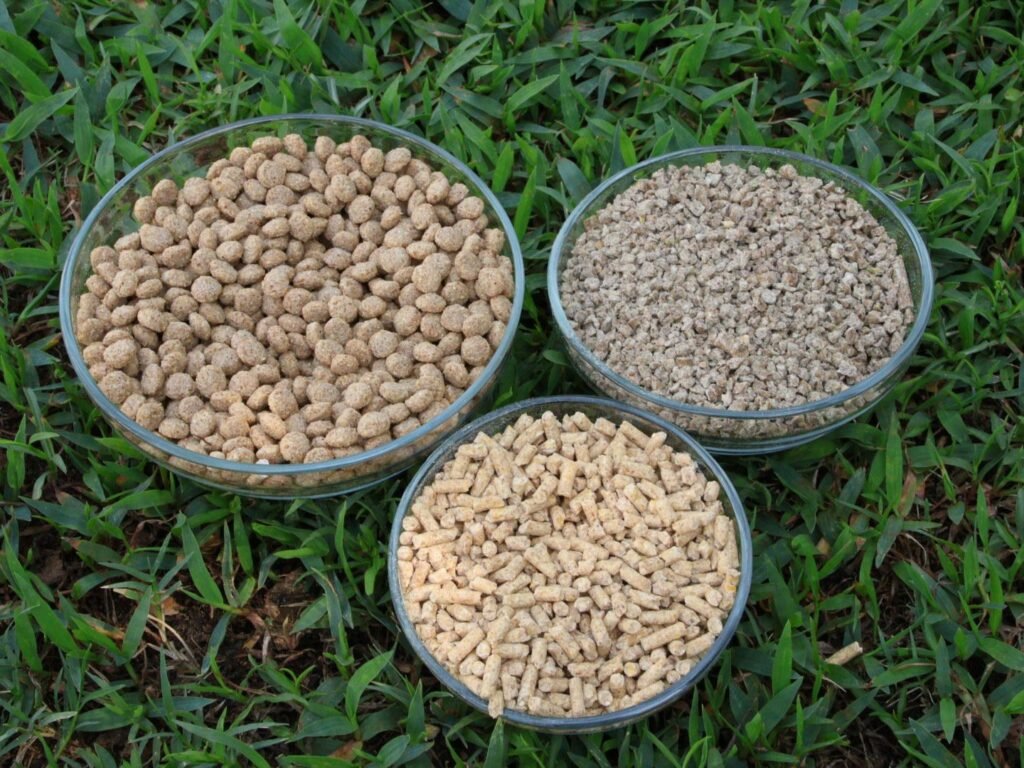
🔬 Science Note: Ducks are inefficient at converting the amino acid tryptophan into niacin compared to mammals. That’s why niacin must come directly from their diet rather than relying on metabolic conversion.
Daily Greens: Natural Dabbling and Enrichment
- Ducks are natural foragers, evolved to nibble on aquatic vegetation and grasses. Offering leafy greens like romaine, kale, or dandelion floating in water not only provides vitamins (A, C, K, folate) but also encourages natural dabbling behavior.
- Floating greens keep food clean, prevent spoilage, and reduce choking risk.
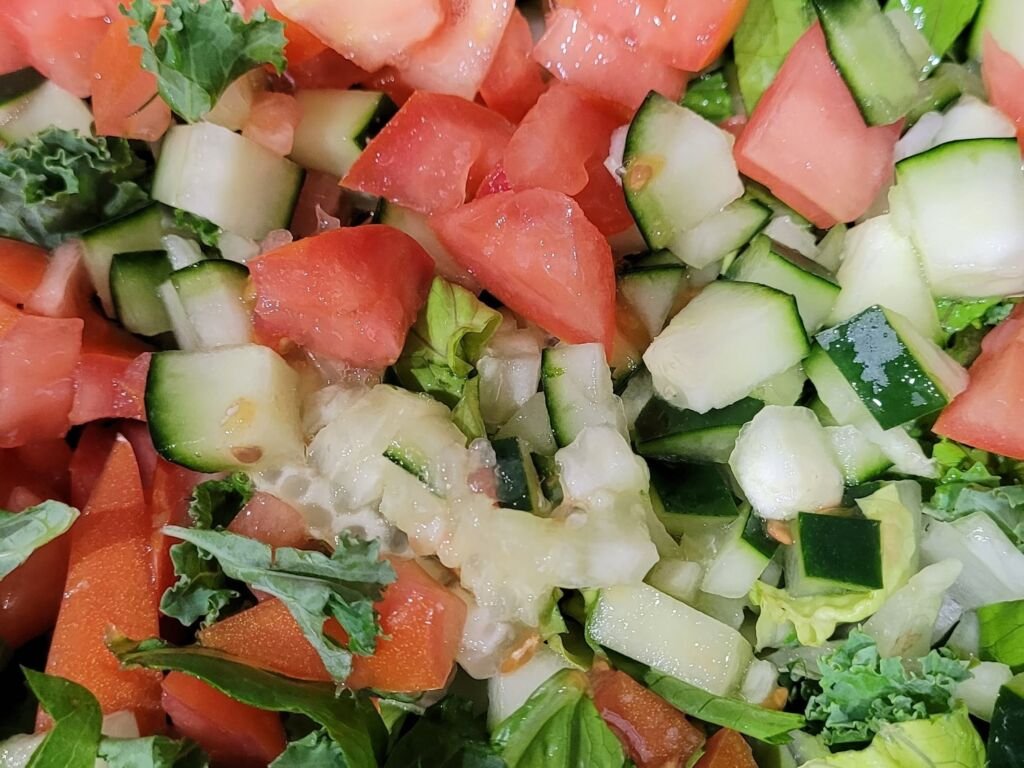
🔬 Science Note: Greens provide carotenoids, natural pigments that support vibrant feather color and strong immune function. Ducks also benefit from the fiber content, which aids digestion and gut health.
Treats in Moderation: Fun but Controlled
- Ducks love treats like peas, cucumber, melon, tomatoes, or dried black soldier fly larvae (Grubblies). These add variety, protein, and hydration, but should remain under 10% of the diet.
- The exception is leafy greens, which can be offered more generously because they’re low in calories and high in nutrients.
- Avoid high-carb fillers (bread, pasta, rice) which add calories without nutrition.
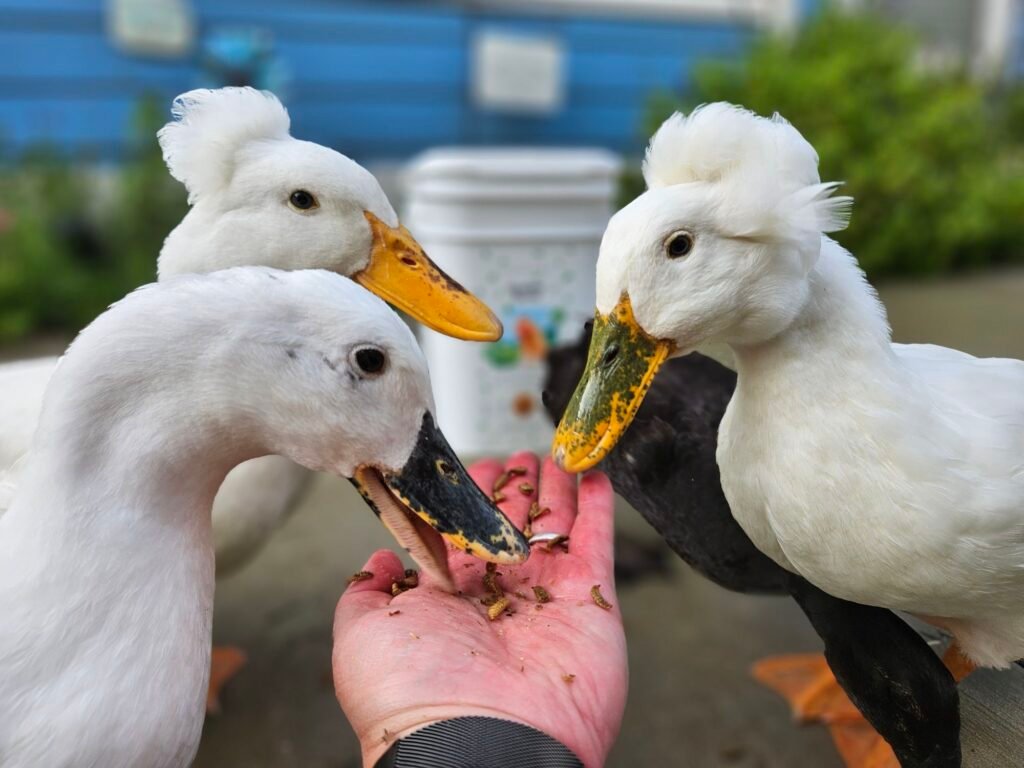
🔬 Science Note: Too many high-energy treats can disrupt the protein-to-carbohydrate balance in a duck’s diet, increasing the risk of obesity, fatty liver disease, and egg-laying issues.
Supplements: As Needed, Not as Routine
- Oyster shell: For laying hens, calcium is crucial. Ducks are excellent at self-regulating; they’ll eat it when they need it and ignore it otherwise.
- Niacin: Essential for ducklings, especially larger breeds like Pekins. Supplement with plain niacin (150 mg/gallon of drinking water) if your starter feed isn’t formulated for ducks.
- Probiotics and vitamins: Helpful during stress (molting, illness, after antibiotics), but not required daily.
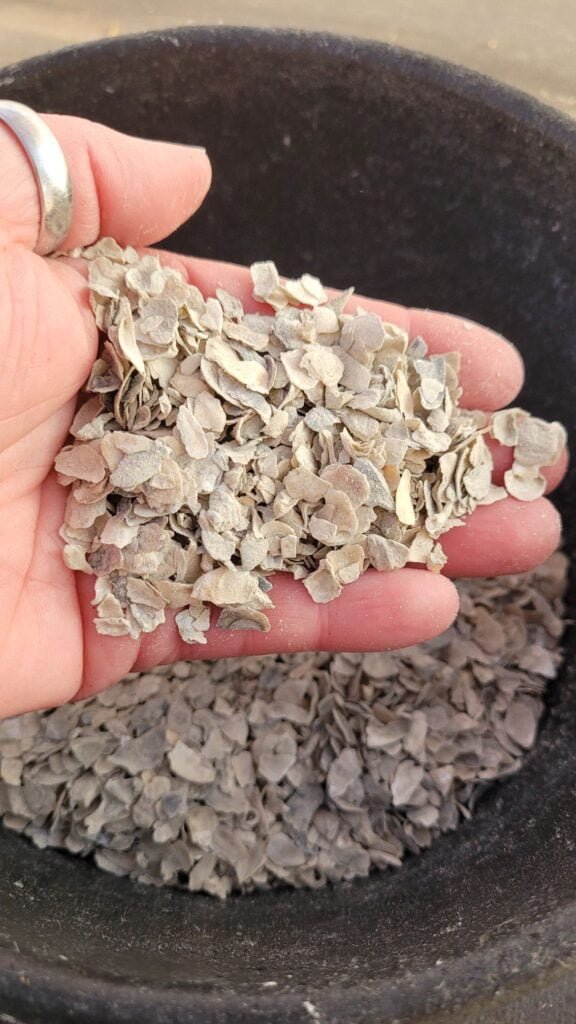
🔬 Science Note: Proper calcium metabolism requires Vitamin D3 and phosphorus in balance with calcium. That’s why relying on dairy or random supplements is unsafe—formulated feeds and oyster shell ensure the ratios are correct.
Fresh Water: Essential for Digestion and Health
- Ducks must have clean water deep enough to submerge their bills at all times. They need it to swallow feed safely, wash out their nostrils, and maintain healthy eyes.
- Water also plays a role in preventing choking and in the proper functioning of their digestive system. Without it, feed can form clumps in the esophagus or crop.

🔬 Science Note: Unlike chickens, ducks have a different feeding mechanism. Their flat bills scoop and filter food, which must be washed down with water. Without water, their esophagus is prone to impaction, a potentially fatal condition.
Putting It All Together
The healthiest duck diet is built around consistency, balance, and variety.
- Consistency: Daily access to balanced feed ensures nutrient gaps are always covered.
- Balance: Macronutrients (protein, carbs, fats) and micronutrients (vitamins, minerals) must all be in the right proportions—not too much, not too little.
- Variety: Foraging, greens, and occasional treats keep ducks engaged and mimic natural feeding behaviors.
When we feed our ducks this way, we’re not just keeping them alive—we’re supporting glossy feathers, strong bones, steady egg production, and most importantly, a long and happy life as part of the family.
Final Thoughts
Nutrition is at the very heart of duck care. What we choose to put in their feed bowls each day shapes not only their health in the moment, but also their energy, feather quality, egg-laying ability, and long-term well-being. The problem is that so many of the feeding practices we still see today, like bread at the pond, corn as a staple, or chicken feed as “good enough”, come from traditions rooted in farming or convenience, not science.
For farm ducks, bred for rapid growth or short-term egg production, these shortcuts might not cause obvious problems. They simply don’t live long enough for deficiencies or imbalances to fully show. But pet ducks are different. They are companions, not commodities. They rely on us for every aspect of their care, and many of them will share our lives for a decade or more. That makes their nutrition far too important to leave to guesswork or outdated advice.
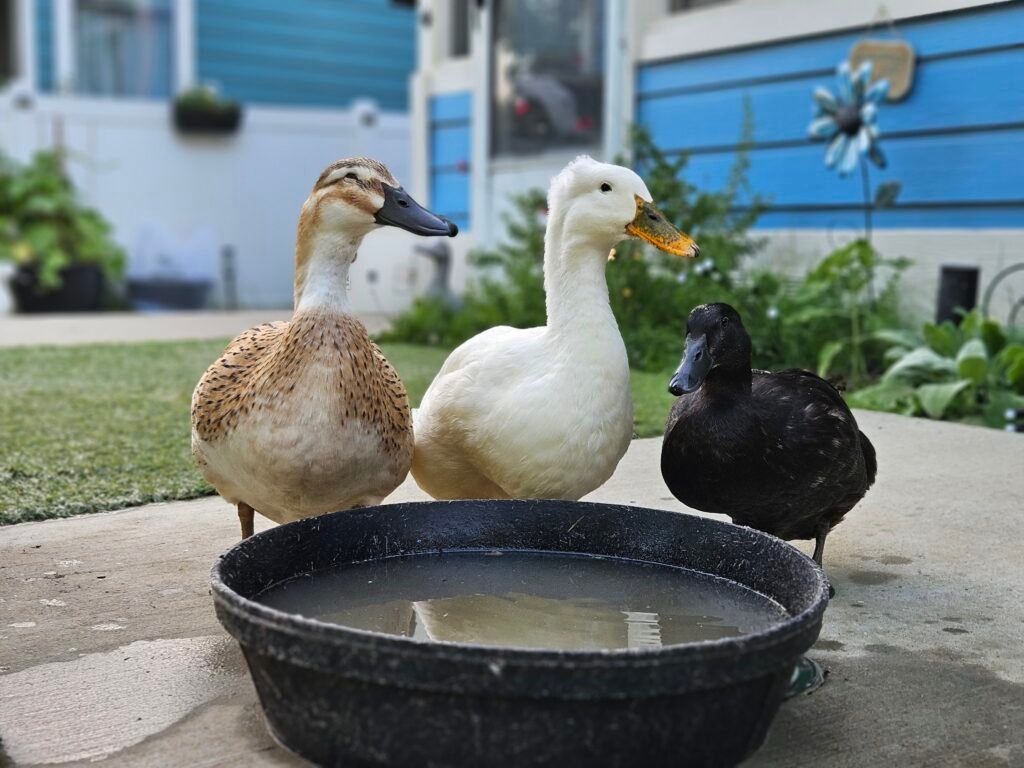
By separating myth from fact, we can make thoughtful feeding choices that prioritize:
- Longevity – supporting healthy organs, bones, and joints for years of active life.
- Quality of Life – keeping ducks strong, glossy, and comfortable through molts, breeding seasons, and aging.
- Natural Behaviors – providing opportunities to forage, dabble, and explore, while ensuring their actual nutrition is always balanced.
As a duck mom myself, I know how tempting it can be to hand over that crust of bread or share a bite of whatever snack I’m eating. But I’ve also seen firsthand how much healthier, happier, and more vibrant my flock is when I stick to science-backed nutrition. And when I watch them diving for peas, shaking their heads with joy, or producing strong, beautiful eggs year after year, I know the extra care is worth it.
At the end of the day, our ducks trust us completely. They can’t choose their diet—we do. By choosing wisely, we give them the greatest gift we can: a long, thriving life full of happy quacks, healthy feathers, and the security of knowing they are loved and well cared for.
Related Articles
- What do Pet Ducks Eat? A Guide to a Healthy and Nutritious Pet Duck Diet
- Essential Nutritional Needs of Ducks: A Complete Overview
- The Ultimate Guide to Healthy Duck Snacks: Treats Your Ducks Will Love
- Commercial Duck Feed Comparison
- Feeding Ducks: A Guide to Keeping Your Flock Happy and Healthy
- Foods Ducks Can and Can’t Eat: The Ultimate Guide for Pet Owners

